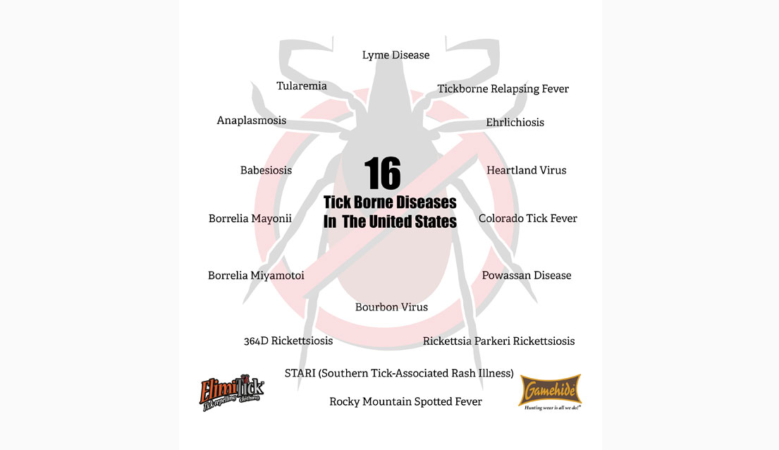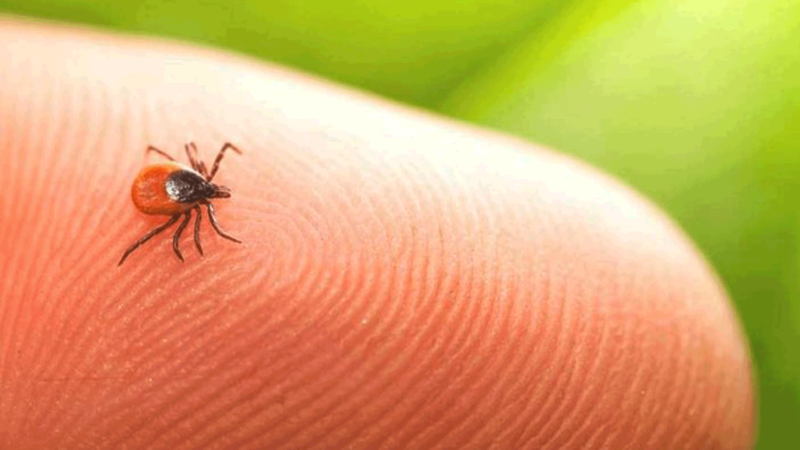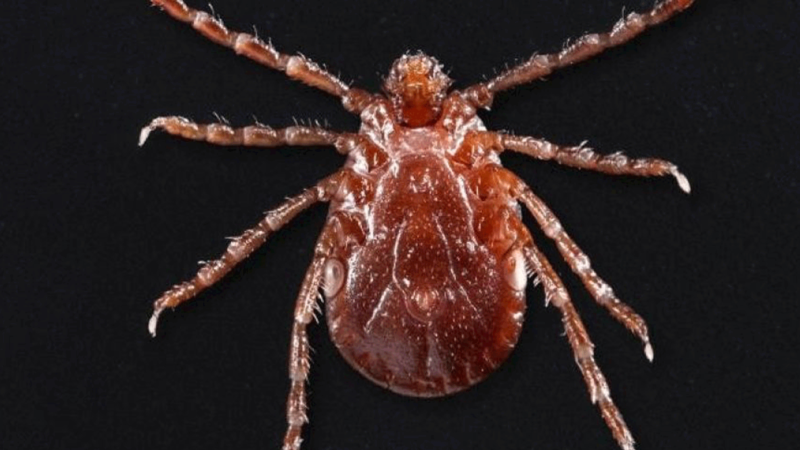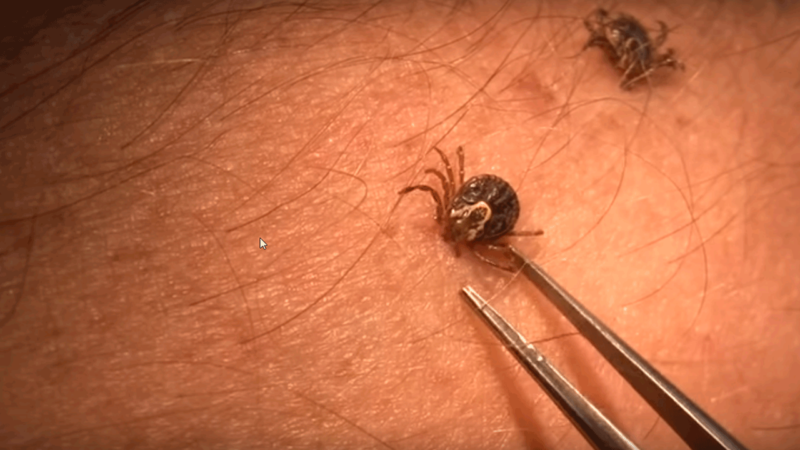LAST UPDATED: June 24th, 2020
The spring season is here once again, and with warmer days on the horizon, it’s time to be thinking about staying protected from ticks.
A lot of hunters fail to take the impact of a tick bite seriously, that is, until they are infected with disease by these little blood suckers. And while you’re likely familiar with Lyme Disease, the fact is, there are many other diseases beyond Lyme Disease that can come from ticks. What are they?
Here’s a list of 16 tick-borne diseases you should know.

Below you’ll find a closer look at the 16 tick-borne diseases found in the United States according to the Center for Disease Control (CDC).
1. Lyme Disease
It is transmitted to humans through the bite of infected blacklegged ticks. Typical symptoms include fever, headache, fatigue, and a characteristic skin rash called erythema migrans. If left untreated, infection can spread to joints, the heart, and the nervous system. Lyme disease is diagnosed based on symptoms, physical findings, and the possibility of exposure to infected ticks.
Laboratory testing is helpful if used correctly and performed with validated methods. Most cases of Lyme disease can be treated successfully with a few weeks of antibiotics.
Steps to prevent Lyme disease include using insect repellent, removing ticks promptly, applying pesticides, and reducing tick habitat.
2. Tick-Borne Relapsing Fever
Relapsing fever is bacterial infection that can cause recurring bouts of fever, headache, muscle and joint aches, and nausea. There are three types of relapsing fever:
- Tick-borne relapsing fever (TBRF)
- Louse-borne relapsing fever (LBRF)
- Borrelia miyamotoi disease (sometimes called hard tick relapsing fever)
TBRF occurs in the western United States and is usually linked to sleeping in rustic, rodent-infested cabins in the mountains. In Texas, TBRF is frequently linked to cave exposures.
LBRF is transmitted by the human body louse and usually occurs in refugee settings in developing parts of the world. Borrelia miyamotoi disease occurs in the same places where Lyme disease is found and is transmitted by the blacklegged tick.
3. Ehrlichiosis
Ehrlichiosis is the general name used to describe diseases caused by a bacteria spread to people primarily through the bite of infected ticks including the lone star tick and the blacklegged tick.
People with ehrlichiosis will often have fever, chills, headache, muscle aches, and sometimes upset stomach. Doxycycline is the treatment of choice for adults and children of all ages with ehrlichiosis.

4. Heartland Virus
Most patients have fever, fatigue, decreased appetite, headache, nausea, diarrhea, and muscle or joint pain.
Patients often have lower than normal counts of white blood cells (cells that help fight infections) and lower than normal counts of platelets (which help clot blood). Sometimes tests to check how well the liver is working can show increased levels of liver enzymes.
The incubation period (time from tick bite to feeling sick) is not known, but most patients reported a tick bite in the 2 weeks before they felt sick.
Almost all patients with Heartland have been hospitalized. Although most patients fully recovered, a few patients died.
There are no vaccines or medications to prevent or treat infection with Heartland virus. Antibiotics do not treat viruses.
Healthcare providers might be able to provide medications and other care to help treat symptoms. Some patients may need to be hospitalized for intravenous fluids and treatment for pain, fever, or other related problems.
5. Colorado Tick Fever
CTF is a rare viral disease spread by infected Rocky Mountain wood ticks in the western United States and western Canada.
The incubation period ranges from about 1 to 14 days.
The most common symptoms of Colorado tick fever are fever, chills, headache, body aches, and feeling tired. Some patients have sore throat, vomiting, abdominal pain, or skin rash.
About half of patients have a “biphasic” fever. This means they have several days of fever, feel better for several days, and then have a second short period of fever and illness.
Most people who become ill have mild disease and recover completely. However, weakness and fatigue may last several weeks.
In rare cases, some patients may develop more severe illness that affects the central nervous system with symptoms that include stiff neck and confusion.
Life-threatening illnesses or deaths due to CTF virus are rare.
There are no medications to treat CTF virus infection at this time.
6. Powassan Disease
Powassan virus is spread to people by the bite of an infected tick. Although still rare, the number of reported cases of people sick from Powassan virus has increased in recent years.
Most cases in the United States occur in the northeast and Great Lakes regions from late spring through mid-fall when ticks are most active. There are no vaccines to prevent or medicines to treat Powassan virus disease. Reduce your risk of infection from Powassan virus by avoiding ticks.

Many people infected with Powassan virus do not have symptoms. For people with symptoms, the time from tick bite to feeling sick ranges from 1 week to 1 month.
Initial symptoms can include: fever, headached, vomitting, and weakness.
Powassan virus can cause severe disease, including infection of the brain (encephalitis) or the membranes around the brain and spinal cord (meningitis). Approximately 1 out of 10 people with severe disease die.
7. Rickettsia Parkeri
Spotted fever group rickettsioses (spotted fevers) are a group of diseases caused by closely related bacteria. These bacteria are spread to people through the bite of infected mites and ticks.
Spotted fevers can range from mild to life-threatening. Most people who get sick with a spotted fever other than RMSF will have an eschar (dark scab at the site of tick or mite bite), fever, headache, and rash. Doxycycline is the treatment of choice for all spotted fever infections.
8. STARI (Southern Tick-Associated Rash Illness)
A rash similar to the rash of Lyme disease has been described in humans following bites of the lone star tick, Amblyomma americanum. The rash may be accompanied by fatigue, fever, headache, muscle and joint pains. This condition has been named southern tick-associated rash illness (STARI). The cause of STARI is not known.
The rash of STARI is a red, expanding “bull’s-eye” lesion that develops around the site of a lone star tick bite. The rash usually appears within 7 days of tick bite and expands to a diameter of 8 centimeters (3 inches) or more.
The rash should not be confused with much smaller areas of redness and discomfort that can occur commonly at the site of any tick bite. Patients may also experience fatigue, headache, fever, and muscle pains. The saliva from lone star ticks can be irritating; redness and discomfort at a bite site does not necessarily indicate an infection.
9. Rocky Mountain Spotted Fever
Rocky Mountain Spotted Fever (RMSF) is a bacterial disease spread through the bite of an infected tick. It is one of the deadliest tickborne diseases in the Americas. Most people who get sick with RMSF will have a fever, headache, and rash. RMSF can be deadly if not treated early with the right antibiotic.
Early signs and symptoms are not specific to RMSF (including fever and headache). However, the disease can rapidly progress to a serious and life-threatening illness. See your healthcare provider if you become ill after having been bitten by a tick or having been in the woods or in areas with high brush where ticks commonly live.
Signs and symptoms can include: fever, headache, rash, nausea, vomitting, stomach pain, muscle pain, and lack of appetite.
10. 364D Rikkettsiosis
364D Rickettsiosis is a species of Rickettsia bacteria. This bacterium is found in the Dermancentor occidentalis tick, which is more commonly known as the Pacific Coast tick.
Ticks carrying 364D Rickettsiosis are most commonly found in northern California and elsewhere on the Pacific Coast.
The infection is spread to humans via bite of the infected tick. Symptoms of 364D Rickettsiosis include fever, malaise, and eschar(s), which is dark, dead skin tissue that eventually sloughs off.
There is not a great deal of knowledge about 364D Rickettsiosis in particular, but doxycycline has been proven effective against Rickettsial infections.
Antibiotics administered in the first week of illness have shown to be highly effective and have the best outcomes.

11. Borrelia Miyamotoi
Borrelia Miyamotoi disease, sometimes called hard tick relapsing fever, has been reported as the cause of human infection in the Upper Midwest, the Northeast, and the mid-Atlantic states, in places where Lyme disease occurs.
Unlike Lyme disease, which is most common in June and July, Borrelia miyamotoi infection occurs most commonly in July and August and may be spread by larval blacklegged ticks. The incucation period ranges from days to weeks.
Signs and symptoms include: fever, chills, fatigue, severe headaches, dizziness, confusion, vertigo, rash, and nausea.
12. Borrelia Mayonii
Borrelia Mayhonii are a type of bacteria recently found in North America that can cause Lyme disease. These bacteria are different from the three types of bacteria that cause most cases of Lyme disease worldwide
It’s believed to only be found in the upper midwest. It has been found in blacklegged ticks collected in northwestern Wisconsin and Minnesota. The blacklegged tick can also transmit B. burgdorferi (the bacteria that causes almost all Lyme disease infections in the United States), and the germs that cause anaplasmosis, babesiosis, and Powassan virus disease.
Symptoms can include: fever, headache, rash, and neck pain in the days after infection and can cause arthritis after a few weeks of illness. Other symptoms include: nausea, vomiting and widespread rashes.
13. Babesiosis
Many people who are infected with Babesia microti feel fine and do not have any symptoms. Some people develop nonspecific flu-like symptoms, such as fever, chills, sweats, headache, body aches, loss of appetite, nausea, or fatigue.
Because Babesia parasites infect and destroy red blood cells, babesiosis can cause a special type of anemia called hemolytic anemia. This type of anemia can lead to jaundice (yellowing of the skin) and dark urine.
Babesiosis can be a severe, life-threatening disease, particularly in people who do not have a spleen, have a weak immune system, or have other serious health conditions.
Complications of babesiosis can include: a low and unstable blood pressure, low platelet count and malfunction of vital organs.
14. Anaplasmosis
Anaplasmosis is a disease caused by the bacterium Anaplasma phagocytophilum. These bacteria are spread to people by tick bites primarily from the blacklegged tick and the western blacklegged tick.
People with anaplasmosis will often have fever, headache, chills, and muscle aches. Doxycycline is the drug of choice for adults and children of all ages with anaplasmosis.
Signs and symptoms of anaplasmosis typically begin within 1–2 weeks after the bite of an infected tick. Tick bites are usually painless, and many people do not remember being bitten.
Early stages and symptoms include; fever, chills, severe headache, muscle aches, nausea, vomiting, diarrhea, loss of appetite. If not addressed, the disease can lead to respiratory failure, bleeding problems, organ failure and even death.
15. Tularemia
Tularemia is a disease that can infect animals and people. Rabbits, hares, and rodents are especially susceptible and often die in large numbers during outbreaks. People can become infected in several ways, including: tick and deer fly bites, skin contact with infected animals, drinking contaminated water, and inhaling contaminated aerosols or agricultural and landscaping dust.
Symptoms vary depending on how the person was infected. And while Tuleremia can be life-threatening, most infections can be treated successfully with antibiotics.
16. Bourbon Virus
The Bourbon virus belongs to a group of viruses called thogotoviruses. Viruses in this group are found all over the world. A few of these viruses can cause people to get sick.We do not yet fully know how people become infected with Bourbon virus. However, based on what we know about similar viruses, it is likely that Bourbon virus is spread through tick or other insect bites.
As of June 2018, a limited number of Bourbon virus disease cases have been identified in the Midwest and southern United States. At this time, we do not know if the virus might be found in other areas of the United States.
Because there have been few cases identified thus far, scientists are still learning about possible symptoms caused by this new virus.
People diagnosed with Bourbon virus disease had symptoms including fever, tiredness, rash, headache, other body aches, nausea, and vomiting. They also had low blood counts for cells that fight infection and help prevent bleeding.
Conclusion
Stay safe out there as the warmer months of spring and summer arrive.
Be sure to treat your clothes and boots with tick repellent or wear tick repelling clothing like ElimiTick when your adventures take you outdoors into tick country. And be sure to make a thorough check for ticks on your body following time in the outdoors.

 By
By 



